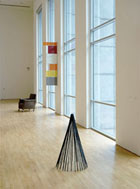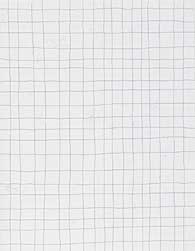
|
Jürgen Partenheimer, La robe des choses, S.M.A.K, 2002 |

|
Cover A la rêveuse matière,
(continuous etching on front and back cover).
|
|
|


During
the last decades the museum space has been the subject of much debate.
It all began in the 1960s and 1970s, when innumerable artists and
art critics prophesied the end of painting. The art of painting,
they believed, would disappear and its place would be taken by the
virtual space of video and web art. And at the dawn of the third
millennium, many believed, the museum, too, would meet an inglorious
end. The rise of Minimal Art and Conceptual Art in particular would
cause both painting and the museum problems. Artists
such as Daniel Buren sought to create an art that would break with
the institutionalized art and the predominance of bourgeois culture.
No one believed in the transcendent power of art any longer. In
fact, the claim to transcendence and the romantic image of the artist
as one who creates unique, sublime works of art, were viciously
attacked. The art institutions, however, were quick to recycle all
radical manifestations of art and proclaim them their new canon,
neutralizing their radical and political character. Near the end
of the 1970s painting, i.e. the painting as a work of art that refers
to something beyond itself and offers a window to the imagination
became feasible once more. The museum as an institution remained
at the center of the debate, but was able to retain its dominant
position. Curators and museum directors were actually able to enhance
their sphere of influence and managed to attract more attention
than the artists whose works they exhibited. Today, the activity
of painting is legitimate once more, but so is questioning the art
of painting. On the one hand, museums prosper to an unprecedented
degree; on the other hand the controversy surrounding them has found
a place within in the debate about contemporary art. But the debate,
though meaningful and fascinating, partly veils reality. Strongly
simplifying the issue, it could be said that the discussion focuses
on the quest of authors, art critics and philosophers for the essence
and definition of "the work of art". It is therefore very
fascinating to exhibit the work of Jürgen Partenheimer, which
is traditionally considered to belong to Post minimal or abstract
Conceptual Art.
Partenheimer's position may be more easily understood viewing his
works from the tradition of Minimal Art. Indeed, his images are
austere, simple and linear; yet, we should hasten to add, they also
bear witness to poetry and emotion. The paintings, drawings, sculptures
and installations can also readily be viewed within the context
of Conceptual Art, as they result from a process of reflection.
Language, literature and philosophy play a major part in Partenheimer's
oeuvre.
Yet,
these views remain unsatisfactory. The above account does not grasp
the full essence of the oeuvre. The fact that the artist refers
to his own work with the term "metaphysical" realism,
illustrates the distance between art criticism on the one hand,
which tries in first instance to capture and explain the works,
and the inherent complexity of the works on the other hand, a complexity
that never can be captured in its entirety. The dense, searching
complexes of lines and areas of color, the wavering geometrical
shapes more often seem inspired by non-Western mythologies than
by visible reality. The frequently small drawings and paintings
are characterized by an extremely clear and simple style. The artist
predominantly uses blues, whites and "soft" shades, such
as yellows and grays, to depict a spiritual and lyrical reality
that often reminds us of the magic and symbolism of Paul Klee and
Joseph Beuys.
The
exhibition in the S.M.A.K. is more than a mere retrospective. During
our conversations with the artist that preceded the exhibition,
it became clear that for Partenheimer every exhibition is a unique
statement. Partenheimer does not put up a fight with the museum
space: he uses it, transforms it and strips it of all non-commitment.
In doing so, he redefines the m museum as a dynamic place, full
of movement, a place that is an essential part of public space and
should be the subject of debate throughout society. Precisely because
the museum can be stripped of any predominant identity, the artist
manages to lend the same spaces ever-new meanings.
In
1997, Partenheimer was invited to a comprehensive show of his work
at the Stedelijk Museum in Amsterdam. The size of the works, their
simple, restrained, poetic imagery bore witness to the fact the
it would be a matter of course that the works were exhibited in
the small cabinet spaces of the museum with faint light, in which
an intimate, meditative atmosphere could be created in harmony with
the works. Instead, the artist preferred to show
the most fragile and vulnerable drawings in the largest, most monumental
gallery of the museum, in which large, monumental installations
and large-sized art works used to be presented to the public. Thus,
Partenheimer not only succeeded in causing wonder and drawing attention:
he also managed to impose a new identity on the room by, as it were,
turning it inside out.
At
the same time, the identity of the work changed. Thus Partenheimer
exposes himself completely. The artist refuses to confine his activities
to that area within the frame of the canvas or drawing, thereby
increasing the vulnerability of the work. The risk of not being
understood or of being misunderstood is ever-present. The impossibility
of non-commitment that was created in this instance, with regard
to both the contemplation of space and the observation of the works,
resulted in a huge potential of the faculties of the imagination
and the intellect.
For the current exhibition in the S.M.A.K., Partenheimer's conceptual
point of departure has been La Robe des Choses, a text from A la
Rêveuse Matière by the French author Francis Ponge.
Reality is veiled, elusive. There is only one-way to fathom its
depths: through thinking. Reflection results in concepts that enable
us to penetrate and reconstruct reality. On the other hand, there
will always remain elements from reality that elude pure reason
and that can only be made visible by art.
Partenheimer's
work must consequently be interpreted as resulting from a coherent
stream of thoughts, with which the artist does not so much want
to reveal or evoke a certain reality, as to show us and discuss
the reflections that accompany our "being in this reality".
Quite often dogmas are undermined by new dogmas. That, precisely,
is what Partenheimer seeks to avoid. An image, in Partenheimer's
view, is only interesting if it can constantly bring about new streams
of ideas. The principle of association is important both when creating
the image, as well as when contemplating it. The act of thinking
becomes one with the image, which is never a conclusive fact.
Weltachse
is a work that illustrates this idea wonderfully. The work is essentially
a vertical axis, consisting of various blue cubes, piled on top
of each other. Partenheimer exhibited this work for the first time
in 1993 at the Gemeentemuseum in The Hague. The playing with H.P.
Berlage's architecture is obvious. The axis is not only the focus
of our attention; it also emphasizes the particular character and
the beauty of the geometrical shapes of the building. A unique tension
between the sculpture and the environment is the result, a tension
that is unmistakable, yet devoid of anecdotes. The tension, on the
other hand, that resulted from the installation of the same sculpture
in the Vondelpark in Amsterdam (1997) was completely different.
In this instance we were confronted with a tension between heaven
and earth, nature and culture. New meanings resulted from the installation
of the work in China during a long-term exhibition project that
lasted several years. In 2000 the sculpture almost became a political
signal, when it was installed in the outer precinct of the Forbidden
City. Later, flowing on the Yangtze River, the tension between sculpture
and nature strongly increased. At the same time the work was about
the verticality of the sculpture versus the horizontality of the
landscape, about the Eastern way of looking versus the Western way
of thinking. In the S.M.A.K. the sculpture will be on view in a
showcase. All cubes have been neatly piled underneath a glass cover.
The public is thus invited to create the image himself or herself
according the artist's theory: "All sculpture is essentially
conceptual. It does not have a final, definite form or a fixed,
spatial dimension. As a model, as a monument of the imagination,
a sculpture assumes those dimensions, which it needs for the respective
environment in which it is shown. Any work may be altered and its
dimensions deliberately adapted to the place chosen for its showing,
be it a geometrically architectural room or an open, natural space".
The
latter example illustrates the fact that Partenheimer is constantly
appealing to the public's imagination and intellect. His sculpture
therefore, though at first sight they often seem a complete, separate
entity, never becomes hermetic. The artist invites us to embark
on a visual and intellectual expedition, and precisely for that
reason he emphasizes so strongly the individual character of his
statement. Partenheimer wants to create spaces of contemplation
that cannot be reduced to a harmonic interplay between architecture
and art: they demand real involvement from the public.
In that sense he brings the problems which Minimal Art had addressed
up to date, while at the same time taking the issue to a new level.
In
the same way Partenheimer also engages in the medium of bookmaking
and publishing – which have a prominent place in his oeuvre –. Partenheimer's
interest in books not merely results from a great love for the written
word. Just like the image is a collection of signs, which constitute
a veil that both hides and reveals reality, so is the written word.
The book is a mental space, a unique and at the same times a universal
context in which both imagination and reflection have a place. The
book, furthermore, stresses the individual character of the journey
to which the artist invites the reader.
With
extreme effectiveness Partenheimer time and again succeeds in creating
a new universe, in which works of art are signs and signals that
open the gates of a metaphysical, even spiritual reality.
>Rolf Quaghebeur, The Act of Thinking, in 'La robe des chose's,
S.M.A.K., Ghent 2002. |




|
|